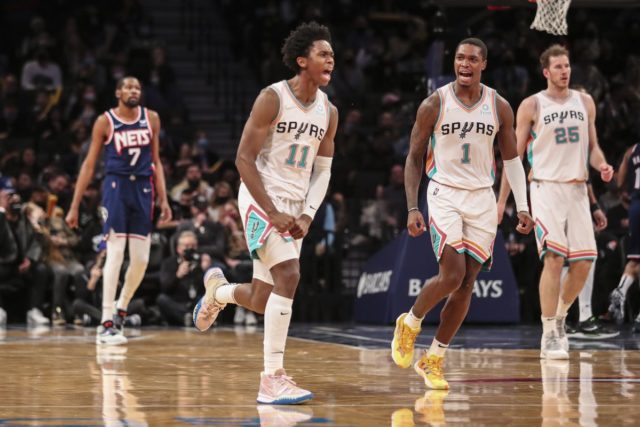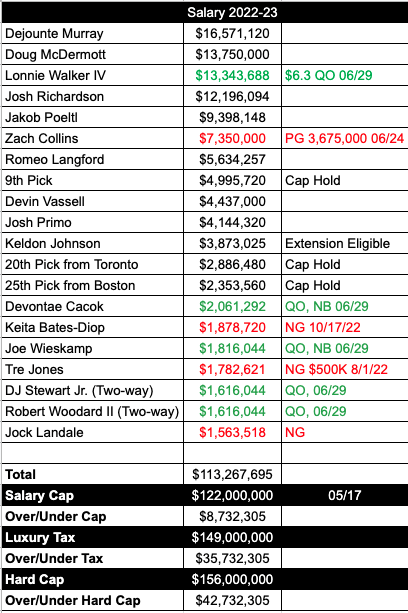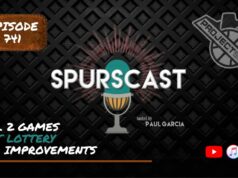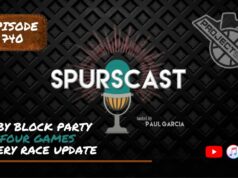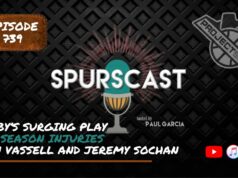With the NBA Draft approaching next Thursday (June 23) and then free agency following shortly after on June 30, it’s time to look at the San Antonio Spurs’ roster heading into the offseason.
June 23 – NBA Draft
Heading into the NBA Draft, the Spurs will have four picks, with three picks in the first round and one in the second round.
The Spurs will draft 9th in the lottery, 20th in the first round via the Toronto Raptors, 25th in the first round via the Boston Celtics, and 38th in the second round via the Los Angeles Lakers.
One scenario to watch is whether the Spurs make any trades involving any of these picks. The Spurs already have 8 players under guaranteed contracts for next season, and when you account for the three first round picks, that’s already 11 players on the roster.
While teams can carry up to 20 players on their roster in the offseason, by opening night, the roster has to be trimmed to 15 players and 2 two-way players.
Because first round picks have cap holds, those three slots are already added to the Spurs’ roster. So again, 11 players on the roster, and the Spurs still need to make decisions on four players who don’t have fully guaranteed contracts (Zach Collins, Keita Bates-Diop, Tre Jones, Jock Landale).
That’s 14 players now on the roster when you add the players who don’t have guaranteed deals. Now throw in the fact that the Spurs will have 5 players entering free agency.
So with a roster that’s already almost full before free agency begins, will the Spurs move some of those first round picks, whether that be moving up or down in the draft, or trading for a future pick?
June 24 – Zach Collin’ Contract Guarantee Date
Following the draft, the Spurs will have to make a decision on Collins’ $7.4 million contract for next season. If the Spurs were to waive Collins, he would still have $3.4 million of his contract partially guaranteed for next season.
June 29 – Restricted Free Agent Qualifying Offers
The Spurs have until June 29 to tender the following players qualifying offers so the players enter free agency June 30 as restricted free agents.
Lonnie Walker IV – $6.3 million qualifying offer
Devontae Cacok – $2 million qualifying offer
Joe Wieskamp – $1.8 million qualifying offer
DJ Stewart – $1.6 million qualifying offer
Robert Woodard II – $1.6 million qualifying offer
For this review of how restricted free agency works, let’s use Walker IV. First the Spurs will tender Walker IV the qualifying offer by or on June 29. Once free agency begins June 30, Walker IV can start negotiating with the Spurs or other teams. Let’s say Walker IV and Team X agree to an offer sheet, so Walker IV signs the offer sheet. On July 6, when the NBA lifts the moratorium, the Spurs have 48 hours to match the offer sheet for Walker IV to the terms on the sheet, or they could refuse, and then Walker IV would now be signed to that new team to the terms of the offer sheet.
As long as Walker IV doesn’t sign an offer sheet, there’s also the possibility of the Spurs, Walker IV, and Team X to come to an agreement on a sign-and-trade agreement. This would only be the case if the Spurs knew Walker IV wanted to leave San Antonio and they had no intention of matching a proposed offer sheet. This would give the Spurs the opportunity to help Walker IV land with his new team while also trying to get back some assets from that team.
There is also a date in July when the Spurs are able to pull the qualifying offer if they decide to go in a different direction from a restricted free agent. If they do this, then the player would become an unrestricted free agent.
If a player doesn’t sign an offer sheet, but he also doesn’t want to re-sign in San Antonio, then he can accept the qualifying offer for next season, play out the season, and then next summer he’ll be an unrestricted free agent.
June 30 – Free Agency Begins
At 5 PM CT, NBA free agency negotiations begin, which means teams can start communicating with their own free agents or other free agents.
The Spurs will be one of the few teams with the ability to open significant cap space this summer. Depending on what the Spurs decide to do with their free agents and players on non-guaranteed contracts, they will be able to open anywhere from $15.8 million to $37 million in cap space.
That $37 million in cap space is enough to offer a max contract to players with 0-6 years of experience, like Deandre Ayton, or a players with 7-9 years of experience, like Zach LaVine.
Operating as a team with cap space will also give the Spurs the ability to use the room exception worth $5.3 million once they use the cap space. The room exception can be used to sign one free agent, or split to sign two players.
August 1 – Tre Jones’ Contract Partially Guarantees
According to Bobby Marks of ESPN, as long as Jones is on the roster still by August 1, his contract will partially guarantee for $500,000.
October 17 – Keita Bates-Diop’s Contract Guarantee Date
The Spurs have until this date to guarantee Bates-Diop’s $1.8 million deal for next season. There aren’t any guarantee dates for Jones’ $1.7 million contract and Landale’s $1.5 million contract for next season per Marks of ESPN.
October – Keldon Johnson Extension Deadline
The Spurs will have from July 1 to the day before the regular season begins in October to extend Keldon Johnson’s contract.
The Spurs recently extended Dejounte Murray and Derrick White’s contracts (before he was traded) in October when they were extension eligible, but they didn’t for Jakob Poeltl or Walker IV when they were extension eligible.
Murray’s extension was for 4 years, for a total of $64 million. He hadn’t made an All-Star team by that point, but he had made the All-NBA defensive second team in a previous season. White was signed to a 4-year extension for $70 million per spotrac.com.
If the Spurs don’t extend Johnson’s contract this offseason, then he’ll be a restricted free agent next summer.


